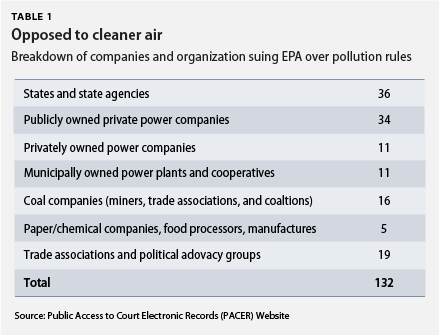In a blatant insult to the millions of Americans who would breathe easier under the EPA’s air pollution controls, the dirty energy industry, along with other groups, has sued the EPA to stop regulating toxic industrial air pollution. The Center for American Progress has the story:
Two essential Environmental Protection Agency, or EPA, regulations to protect children, seniors, the infirm, and others from air pollution are under attack from the coal industry and many utilities.
Last year the EPA issued two rules that would reduce smog, acid rain, and airborne toxic chemicals: the Cross-State Air Pollution Rule and the Mercury and Air Toxics Standards.
On July 6, 2011, the EPA finalized the Cross-State Air Pollution Rule to reduce sulfur dioxide and nitrogen oxide pollution—two of the main ingredients in acid rain and smog—from power plants in upwind states that were polluting downwind states. An interactive EPA map demonstrates that pollution doesn’t stop at state borders.
Then, on December 16, 2011, the EPA finalized the first standards to reduce mercury, arsenic, lead, and other toxic air pollution 21 years after controls on such pollution became law.
Today more than 130 coal companies, electric utilities, trade associations, other polluting industries, and states are suing the EPA in federal court to obliterate, undermine, or delay these essential health protection standards. A parallel effort is underway to block the mercury reduction rule in the Senate, which is scheduled to vote on it this week. This CAP investigation found that these utilities were responsible for 33,000 pounds of mercury and 6.5 billion pounds of smog and acid rain pollution in 2010 alone.
The industry has been actively working to undermine the work of the EPA for years, and this lawsuit comes on the heels of a package of legislation recently introduced by House Republicans that would gut the EPA of most of their regulatory authority over air pollution emissions, including mercury emissions.
The EPA rules, if enforced to the full extent, would have prevented as many as 11,000 premature deaths every year. Additionally, they could have prevented 130,000 asthma attacks and 5,000 heart attacks, according to research by the NRDC.
The Mercury and Air Toxins Standards (MATS) rule has been the focus of both industry and Republican ire for the last few years. Recently, noted climate-change denier James Inhofe proposed a resolution that would completely prevent the EPA from enacting MATS, and limit their ability to regulate emissions from power plants as a whole. That resolution will be coming to a floor vote in the near future, but it is unlikely that the legislation will pass the Democratic-controlled Senate.
The NRDC explains how the industry (and industry-friendly politicians) have attacked MATS through what the NRDC is calling the “Mercury Soot Shell Game,” which was on full display at Senate hearings in April when Sen. Inhofe was attempting to gain support for the repeal of the standards:
In this maneuver, industry lobbyists and obedient politicians first pretend that EPA’s air toxics standards are only about reducing mercury pollution from power plants. See Mr. Holmstead’s written testimony at pages 2, 3, 4 & 5. If the standards are only about mercury (which of course they are not), then, the industry argument follows, it’s somehow inappropriate for these standards also to reduce soot pollution (so-called “PM2.5” or fine particle pollution) that is unavoidably and necessarily reduced when you control all of a power plant’s toxic air pollution.
According to this peculiar industry line of argument, because EPA sets National Ambient Air Quality Standards for PM2.5 pollution, then EPA should only reduce that pollution under one subpart of the Clean Air Act and not another. See Ms. Dudley’s testimony at page 4 and Mr. Holmstead’s at pages 3-4.
Jeff Holmstead, who testified at Inhofe’s hearings, was the head of the EPA’s air division in the George W. Bush administration. He was known for completely evading any form of regulations for the energy industry during his tenure. The NRDC went on to talk about why these claims are bogus – to put it succinctly, the industry is trying to make the claim that MATS rules only apply to mercury, and therefore are unfairly targeting their businesses. However, the rules apply to more than 60 different toxic chemicals that are released into the air from all sorts of industries, meaning that there isn’t one specific corporation or industry that is being singled out.
The lawsuit filed by the industry and allies has made their attack on the EPA and MATS into a three-pronged assault, that now includes industry lobbying, political maneuvering by special interest operatives, and a legal battle that will take place in the courts.
They only need to be successful in one of these areas to win the war, and even with the millions they’ve spent buying members of Congress, the court battle could be the easiest route to victory. The losers will be the vulnerable populations who are hurt most by industrial pollution.
Subscribe to our newsletter
Stay up to date with DeSmog news and alerts







